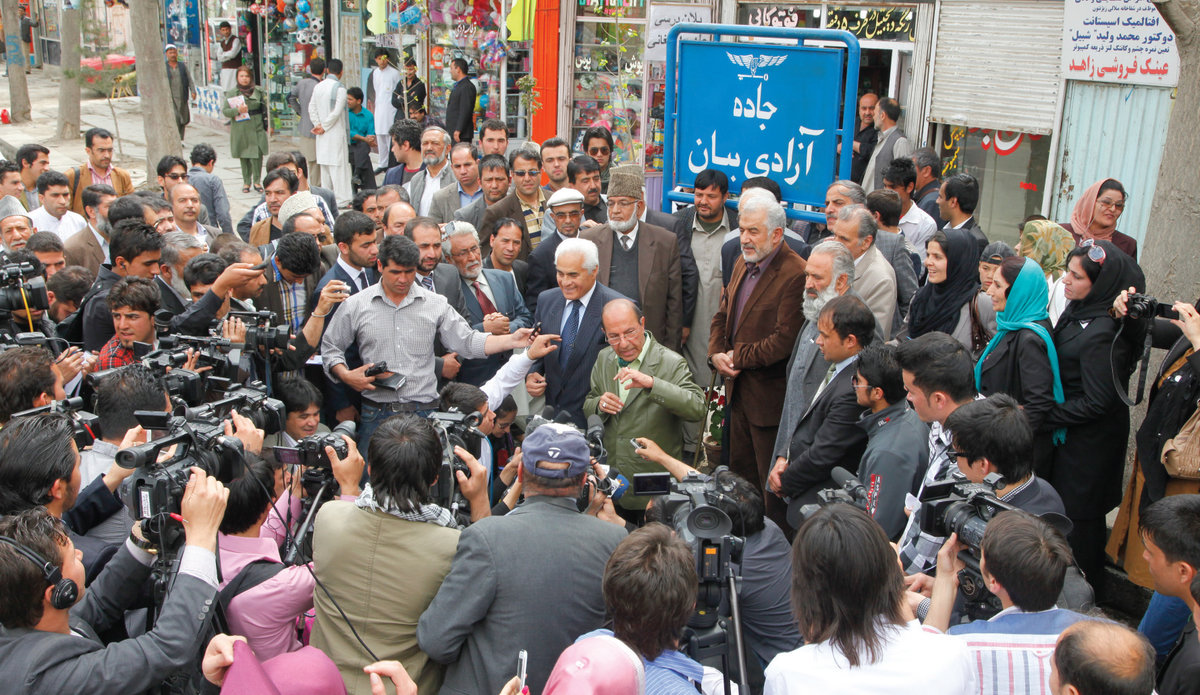Afghanistan strengthens press freedoms
KABUL- In the Shahr-e-Naw area of Kabul, new signs reading “Freedom of Speech Road” went up as part of an initiative of the Ministry of Information and Culture (MoIC) and media watchdogs ahead of the celebration of World Press Freedom Day and in recognition of the work of Afghan journalists.
“Freedom of speech is now institutionalized in Afghanistan; this will never be reversed,” said Sayed Makhdoom Raheen, the Minister for Information and Culture, during the ceremony to inaugurate the new street signs. “This wouldn’t have been possible without the relentless and brave struggle of our journalists and media organizations.”
As in other parts of the world, press freedoms in Afghanistan are the lifeblood of democracy, not only encouraging social, political and economic deliberation, but also fostering accountability for good governance. As such, press freedoms are tightly linked to basic human rights.
The Afghan Constitution allows for freedom of the press and of expression. The country’s Mass Media Law, which came into effect in 2009, prohibits censorship and guarantees the citizens the right to obtain information.
The draft of another significant law, Access to Information, has been approved by the Cabinet Council and the Lower House of the Afghan Parliament. Drafted by civil society organizations and human rights networks, the legislation, if made law, will be applied to state institutions at the national and subnational level.
During the Taliban regime’s rule, the media sector was restricted to one radio broadcaster and a limited number of newspapers and magazines. Since 2001, the sector has grown dramatically. According to Afghan media watchdog Nai, nearly 100 television channels are currently registered with the Ministry of Information and Culture, with more than 50 of them actively broadcasting. There are now 172 radio stations, and some 300 newspapers and magazines currently in print or online.
“The presence of such a huge number of media institutions, hundreds of journalists, relevant legislation and the active performance of the media are the biggest achievements during last 13 years in Afghanistan,” says the Executive Director of Nai, Mujeeb Khilwatgar.
In addition to the rise in the number of media agencies, there has been rapid growth in the number of journalists’ associations and networks designed to defend the rights of media personnel and advocate for press freedoms. Nine of these advocacy institutions last year formed an umbrella organization, the Afghanistan Journalists’ Federation.
Along with these developments, social media use is growing in the country, particularly among young people. Smartphones have made it easy to receive news headlines on mobile devices and share opinions on Facebook and Twitter. The prevalence 3G services and the availability of less expensive internet access have fostered eyewitness citizen reporting in the country.
However, journalists and affiliates of media organizations continue to be threatened in the ongoing military conflict. According to Nai, in 2013 alone there were 78 cases of violence against journalists, with 50 of these involving Afghan security forces, eight involving the Taliban and five involving international security forces. The 78 cases include six journalists killed, four wounded and 35 physically assaulted.
“Increased insecurity has taken a toll on freedom of speech in the country,” says Nai’s director.
The Afghan Journalist Safety Committee (AJSC), in its August report, documented a 60 per cent increase in cases of violence against journalists during the first six months of the year. “If we compare with the first six months of 2013, we have a 60 per cent increase in the cases of violence against journalists in 2014, which is deeply concerning,” says Najeeb Sharifi, AJSC’s director.
Following the killing of two international journalists, Anja Niedringhaus and Kathy Gannon, in the south-eastern Afghan province of Khost on 4 April, the UN Secretary-General’s Special Representative for the country, Ján Kubiš, said he was “outraged by this terror attack.”
In recognition of increasing threats to journalists, this year’s World Press Freedom Day focused on defending the media from attacks on their independence and paying tribute to journalists who have lost their lives in the line of duty.
The world body’s chief, Ban Ki-moon, and the Director-General of UNESCO, Irina Bokova, in a joint message for the World Press Freedom Day this year, called for more journalist protections.
“In many countries, journalists and other media workers face systematic obstacles to reporting the truth, ranging from censorship, arrest and imprisonment to intimidation, attacks and even assassination,” the two UN officials said. “These outrageous abuses show that press freedom and the human rights it underpins are extremely fragile and must be actively defended.”
In the wake of the celebrations of World Press Freedom Day, the United Nations Assistance Mission in Afghanistan organized several roundtable discussions on media issues and to pay tribute to the martyred journalists. These roundtables were covered by the media in the southern province of Kandahar, the western province of Herat, the northern province of Balkh and the eastern province of Nangarhar.
The discussions involved media experts, academics, governmental officials, civil society representatives and UN officials. They shed light on issues related to press freedoms in Afghanistan, and paid tribute to the journalists for their bravery and sacrifices.
 UN
UN







